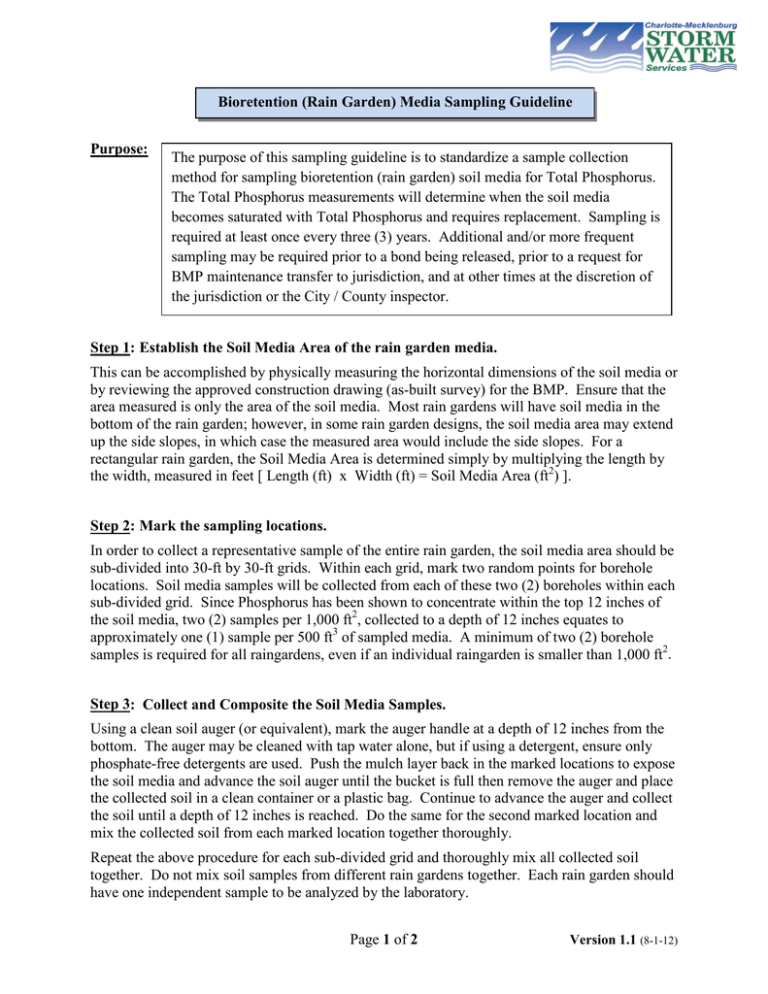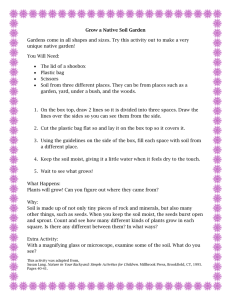The purpose of this sampling guideline is to standardize a... method for sampling bioretention (rain garden) soil media for Total... Bioretention (Rain Garden) Media Sampling Guideline
advertisement

Bioretention (Rain Garden) Media Sampling Guideline Purpose: The purpose of this sampling guideline is to standardize a sample collection method for sampling bioretention (rain garden) soil media for Total Phosphorus. The Total Phosphorus measurements will determine when the soil media becomes saturated with Total Phosphorus and requires replacement. Sampling is required at least once every three (3) years. Additional and/or more frequent sampling may be required prior to a bond being released, prior to a request for BMP maintenance transfer to jurisdiction, and at other times at the discretion of the jurisdiction or the City / County inspector. Step 1: Establish the Soil Media Area of the rain garden media. This can be accomplished by physically measuring the horizontal dimensions of the soil media or by reviewing the approved construction drawing (as-built survey) for the BMP. Ensure that the area measured is only the area of the soil media. Most rain gardens will have soil media in the bottom of the rain garden; however, in some rain garden designs, the soil media area may extend up the side slopes, in which case the measured area would include the side slopes. For a rectangular rain garden, the Soil Media Area is determined simply by multiplying the length by the width, measured in feet [ Length (ft) x Width (ft) = Soil Media Area (ft2) ]. Step 2: Mark the sampling locations. In order to collect a representative sample of the entire rain garden, the soil media area should be sub-divided into 30-ft by 30-ft grids. Within each grid, mark two random points for borehole locations. Soil media samples will be collected from each of these two (2) boreholes within each sub-divided grid. Since Phosphorus has been shown to concentrate within the top 12 inches of the soil media, two (2) samples per 1,000 ft2, collected to a depth of 12 inches equates to approximately one (1) sample per 500 ft3 of sampled media. A minimum of two (2) borehole samples is required for all raingardens, even if an individual raingarden is smaller than 1,000 ft2. Step 3: Collect and Composite the Soil Media Samples. Using a clean soil auger (or equivalent), mark the auger handle at a depth of 12 inches from the bottom. The auger may be cleaned with tap water alone, but if using a detergent, ensure only phosphate-free detergents are used. Push the mulch layer back in the marked locations to expose the soil media and advance the soil auger until the bucket is full then remove the auger and place the collected soil in a clean container or a plastic bag. Continue to advance the auger and collect the soil until a depth of 12 inches is reached. Do the same for the second marked location and mix the collected soil from each marked location together thoroughly. Repeat the above procedure for each sub-divided grid and thoroughly mix all collected soil together. Do not mix soil samples from different rain gardens together. Each rain garden should have one independent sample to be analyzed by the laboratory. Page 1 of 2 Version 1.1 (8-1-12) Step 4: Prepare Samples for Laboratory Analysis. Place the composited soil sample in a container provided by the laboratory, complete the appropriate shipping paperwork (oftentimes referred to as Sample Information Sheet or Chainof-Custody), and ship according to laboratory direction. Ensure the laboratory is capable of testing for Phosphorus Index using Mehlich 3 extraction techniques and will report results on a dry basis. The name of the project, test method, and rain garden must appear on the laboratory results. Step 5: Submission of Laboratory Results. Laboratory results should be submitted to the appropriate person depending upon which jurisdiction the sample was collected: • City of Charlotte, email Mike MacIntyre at mmacintyre@ci.charlotte.nc.us • Towns of Cornelius, Davidson, Huntersville, Matthews, Mint Hill or Pineville: email Heather Davis at heather.davis@mecklenburgcountync.gov Step 6: Review of Laboratory Results. Bioretention soils with a Phosphorus Index equal to or greater than 50 (P-I > 50) have lost the capacity to remove phosphorus. The appropriate City or County inspector will contact you regarding the need to perform soil media replacement. Page 2 of 2 Version 1.1 (8-1-12)





